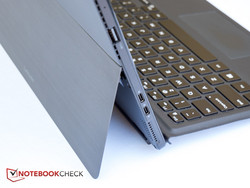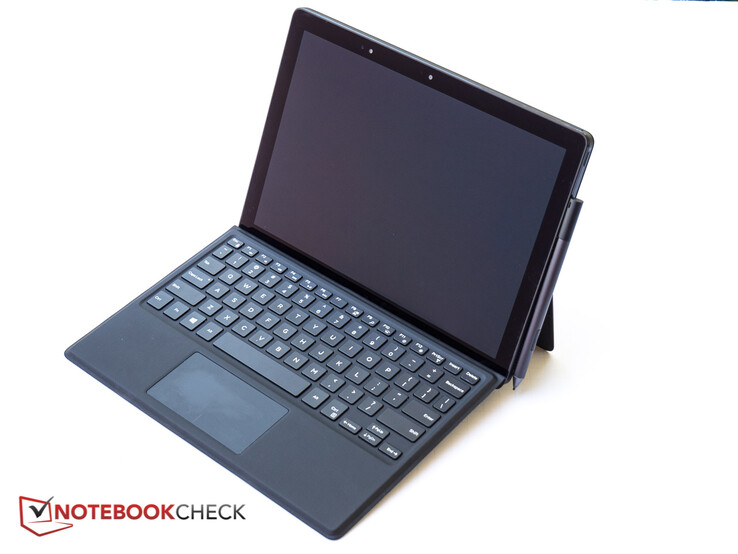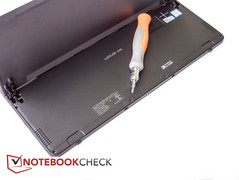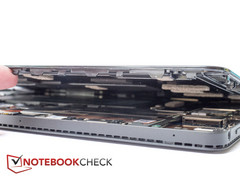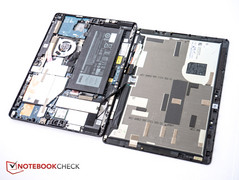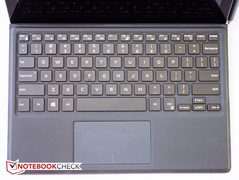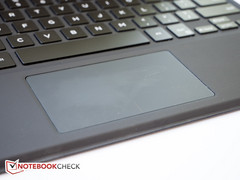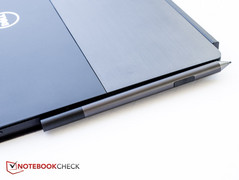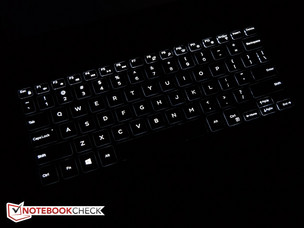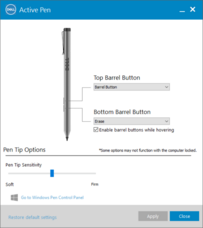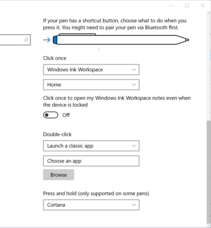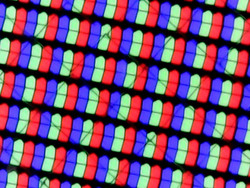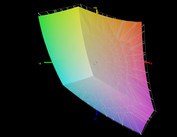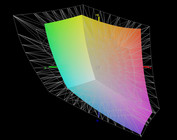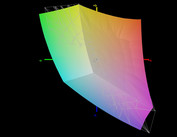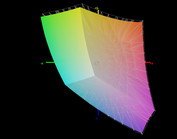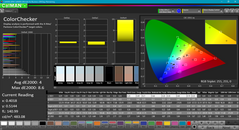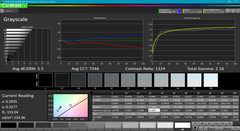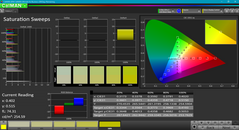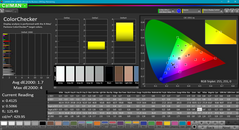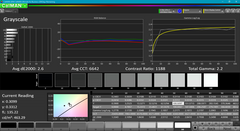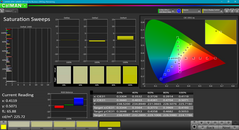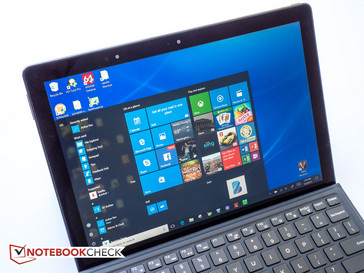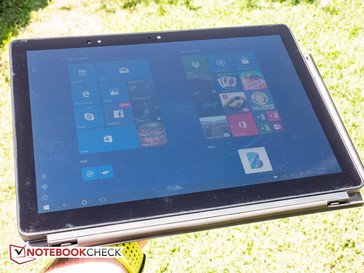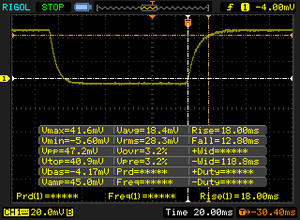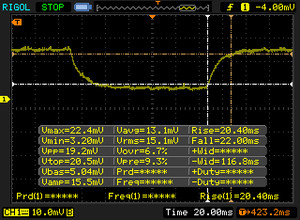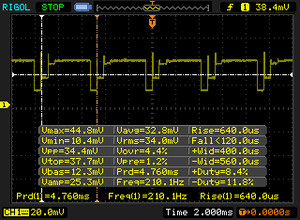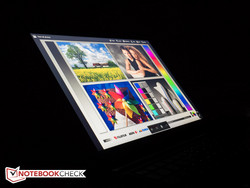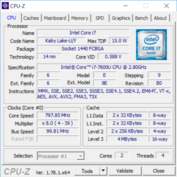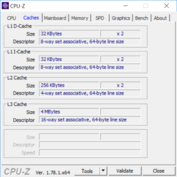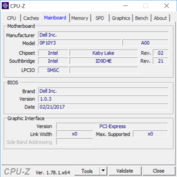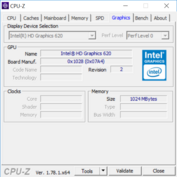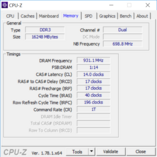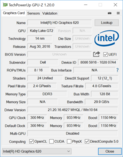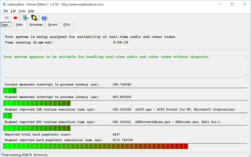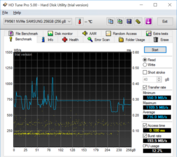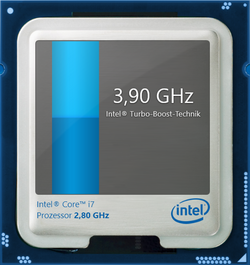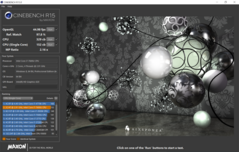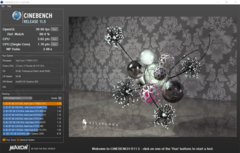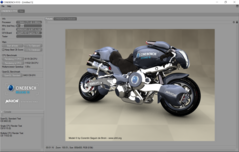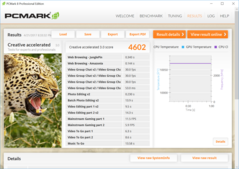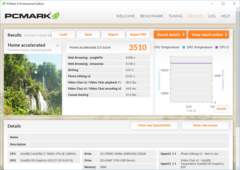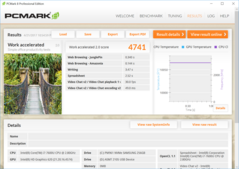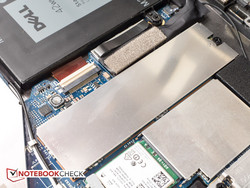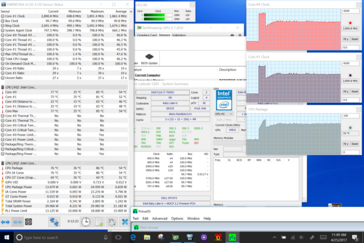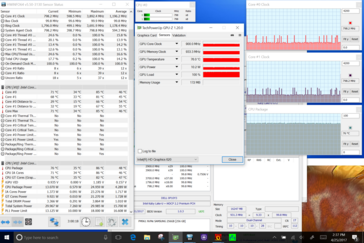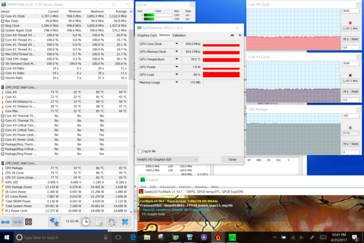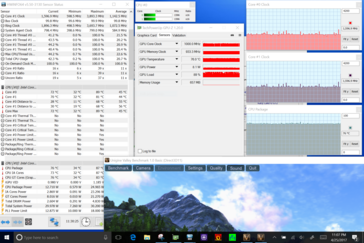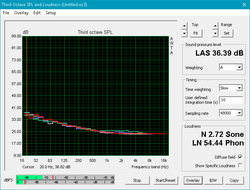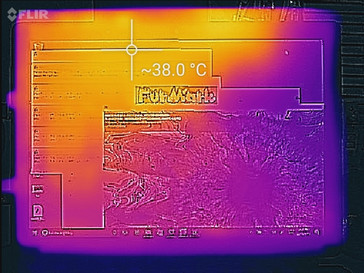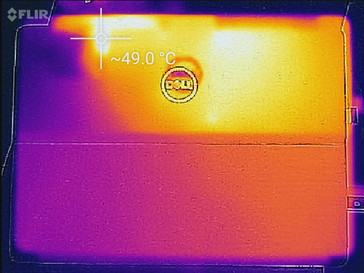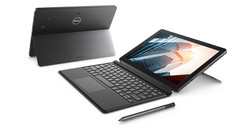Dell Latitude 12 5285 2-in-1 Convertible Review
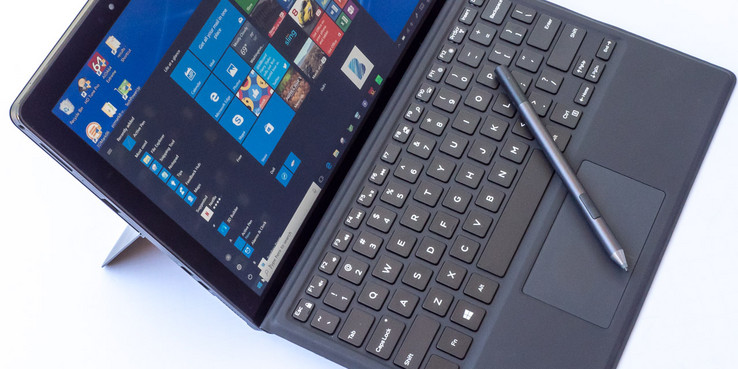
"The power of a laptop and flexibility of a tablet" - the concept isn't exactly new. Microsoft's fourth-generation of the - as of right now - still-current Surface Pro 4 with 6th-generation processors was released late 2015. Imitation is the sincerest form of flattery, so we won't hold it against Dell - the Asus Transformer 3 Pro, for example, looks strikingly similar as well. The 12.3-inch review convertible is part of Dell's mid-range 5000-series, but there's a higher-end 7000-series (still based on Skylake processors, however) version as well. Dell also offers the smaller 10.8-inch Latitude 11 5000 2-in-1s, but these models are passively cooled and consequently restricted to much lower-performing Core m CPUs. The Latitude 5289 is - despite a very similar name - a different beast altogether and features a non-detachable, 360-degree-flip Yoga-esque keyboard design. Just like the Surface Pro 4, the Latitude 12 5285 can be equipped with different Core-i processors, but unlike Microsoft, Dell doesn't offer a version based on a Core m processor.
Starting price is about $900, but our review unit with Kaby Lake Core i7 processor, 16 GB of RAM and 256 GB SSD sells for around $2000. Each version includes the tablet with the fold-out stand, but the two top SKUs come with the Travel Keyboard and the Active Pen as well. Even with the accessories bundled, the Dell isn't exactly an inexpensive affair with many competitors costing hundreds less. A similarly-equipped Microsoft Surface Pro 4 - known not to be a bargain - sells for less than $1700 with the Type Cover at the time of writing.
For additional information on various competing 2-in-1s, please check the following articles:
Face Off: Microsoft Surface Pro 4 Core i7 vs. Surface Pro 4 Core i5 vs. Surface Pro 4 Core m3
Case
The Latitude 5285 2-in-1 features a high-quality magnesium-alloy casing and superb build quality. Torsional rigidity is excellent with very minor flex and next to no creaking no matter what forces are applied. The upper half of the back features the familiar, slightly rubberized finish which Dell uses for other models in the Latitude-series. The kickstand, which measures 29.2 x 10.4 cm takes up the lower half of the real estate on the back and consists of a solid sheet of brushed metal. The stand is very resilient as well, so the unit is rock solid when propped up either on its own or when connected to the detachable keyboard. The "auto-deploy" feature, as Dell calls it, is activated via two small tabs sticking out at the bottom. Pushing the slate down vertically onto a flat surface releases the catch mechanism and the stand flips open to about 30 degrees with the 5285 now sitting at an angle of about 15 degrees beyond the vertical. The Travel Keyboard features the same tabs, so the functionality remains here as well. Opening the stand to its maximum of 150 degrees requires considerable force, but on the plus side there is no tethering even when prodding the display vigorously.
The display itself features rather large bezels and is protected by Corning Gorilla Glass 4. The optional travel keyboard - included with our unit - connects via magnets and virtually self-aligns and attaches itself when in close proximity to the bottom of the tablet portion. The connection is very solid and an accidental separation very unlikely. When folded, the keyboard attaches to the tablet via a magnet as well.
According to Dell, the 2-in-1 has undergone extensive military-grade MIL-STD 810G durability testing, so it should withstand rough handling, exposure to heat and cold and even occasional drops quite well, which provides peace of mind, given that slips and fumbles are more likely to happen with a tablet then a larger notebook with a base unit to hold on to.
As we mentioned in our introduction, the tablet portion of the Latitude 5285 is very similar to the Surface Pro 4 as far as the overall dimensions are concerned with Dell's offering measuring one mm thicker and about 7 mm wider (or deeper), which is not nearly enough to be noticeable at all during normal use. With the keyboard attached, the thickness increases to about 15 mm (~0.59 in). HP's Elite x2 1012 G1 is also thinner than the Dell, but features a slightly larger footprint. While the Surface Pro with Core i5 processor weighs about 1100 g with the Type Cover, the Dell tips the scale at 1226 g with its Travel Keyboard attached - a plus of 11 %. Only the Acer Aspire Switch Alpha 12 is a couple ounces heavier, while other competitors are lighter.
Connectivity
Given that this is essentially a tablet, the connectivity options are decent: the Latitude 5285 features a single USB 3.1 Gen 1 port with PowerShare and two USB Type-C ports, which can also be used as Display Ports with an appropriate adapter (not included). When the 2-in-1 is connected to an outlet, one of these two ports will be occupied by the charger cable, which is also USB Type-C. Given the price, we would've also liked to see Thunderbolt 3, which is something the much less expensive Asus Transformer 3 Pro happens to come with. WWAN-equipped models also feature a MicroSIM slot in addition to the slot for the MicroSD card. Both slots are hidden under a removable cover underneath the kickstand.
Some convertibles - like the aforementioned Asus - also come with an HDMI port, but we don't see that omission as too much of a drawback.
SD Card Reader
The performance of the microSD card reader is decent with AS SSD registering transfer rates of 87 MB/s and a jpeg copy test (~ 5 MB each; 1 GB total) taking place at 64 MB/s.
| SD Card Reader | |
| average JPG Copy Test (av. of 3 runs) | |
| Dell Latitude 12 5285 2-in-1 | |
| maximum AS SSD Seq Read Test (1GB) | |
| Dell Latitude 12 5285 2-in-1 | |
Communication
The Intel Dual-Band Wireless-AC 8265 WLAN module supports 2.4 and 5 GHz networks and comes with Bluetooth 4.2. With wireless speeds of 446 MBit/s and 312 MBit/s when connected to our test router Linksys EA8500 (one meter from the test system), the module doesn't even come close to the theoretical maximum of 867 MB/s. Other notebooks with the same adapter - for example the recently reviewed Latitude 7480 - perform significantly better (50+ %); the older Intel Dual-Band module AC-7265 in the Asus Transformer 3 Pro topped out at 685 MBit/s (sending) and 560 MBit/s (receiving) and is much faster as well. That said, the wireless stability was good with no dropouts or other issues during the review period even at large distances from the router.
As with most Latitude business devices, Dell also offers an optional Qualcomm Snapdragon X7 LTE-A (DW5811E) module for AT&T, Verizon and Sprint. At the time of writing, the upgrade cost $140.
| Networking | |
| iperf3 transmit AX12 | |
| Asus Transformer 3 Pro T303UA-GN050T | |
| Microsoft Surface Pro 4, Core i5, 128GB (Klaus I211) | |
| Dell Latitude 12 5285 2-in-1 | |
| iperf3 receive AX12 | |
| Asus Transformer 3 Pro T303UA-GN050T | |
| Microsoft Surface Pro 4, Core i5, 128GB (Klaus I211) | |
| Dell Latitude 12 5285 2-in-1 | |
Security
Our version of the Latitutde 5285 2-in-1 supports TPM 2.0. According to Dell, the optional hardware authentication bundles add a Touch Fingerprint reader and either a Contactless or Contacted Smart Card on the back. The Smart Card Reader, Finger Print Reader, and NFC add $40 to the price, just the Finger Print Reader and NFC $35.
Dell of course also offers different security and management software like Dell Data Protection and Endpoint Security Suite, which are designed to reduce IT management costs and provide single-console management. Most of these services are only available on a subscription basis.
Please note that Intel vPro is only offered on the two higher-priced SKUs with either the Core i5 or Core i7 processor.
Accessories
As mentioned in the intro, our convertible was shipped to us with the Latitude 5285 Travel Keyboard ($130) and the Dell Active Pen PN557W ($60) included. Dell offers many generic accessories, including a Power Bank for USB-C or the also USB-C-based Dock WD 15 for $200, which adds support for 2 FHD displays, two USB 2.0 ports and three USB 3.0 ports, among others.
Maintenance
One area where the Latitude 5285 distinguishes itself from the competition is ease of maintenance. Tablets are notorious for offering very limited or no access at all to the internal components - but with Dell's convertible, the process just takes a few minutes. After removing six small Phillips screws underneath the kickstand, the unit can be disassembled. Although it might not appear that way at first, it's not actually the back plate that's removable - rather, its the Corning Gorilla Glass display, which simply lifts out with the aid of a thin piece of plastic or even the finger nails. The connection tabs between the two parts of the assembly seem plenty sturdy, so even repeated removals should have no detrimental effects on the longevity. The RAM is soldered onto the motherboard, but the PCIe NVMe SSD, the WLAN module and the fan are accessible for upgrades and cleaning.
Warranty
All configurations of the 5285 come standard with a 12-month hardware service with in-home/onsite service after remote diagnosis. At the time of writing, an upgrade to 3 Years ProSupport with next business day onsite service costs $185; 3 years of ProSupport Plus - Dell's version of accidental damage protection - adds about $255 to the total cost. Please see our Guarantees, Return policies and Warranties FAQ for country-specific information.
Cameras
The convertible comes with an 8 MP forward-facing camera with autofocus and a 5 MP user-facing fixed focus camera. Neither camera is very impressive in lower light - images get pixelated very quickly. When we took test pictures in a room equipped with 3x 13W (60W equivalent) Soft White light bulbs above and to the left of the notebook, the two cameras rendered the picture completely differently. While the forward-facing camera had severe issues with the white balance, which resulted in an overly yellow photo, pics taken with the "selfie" camera appeared washed out by comparison. For video conferencing, the user-facing camera is adequate, however. Our review convertible came equipped with IR capability, but Windows Hello didn't give us the option to set up face recognition. We didn't investigate this issue any further.
Input Devices
Keyboard
The Latitude 5285’s optional Chiclet Travel Keyboard features 14 mm plastic keys which are slightly concave and feature a textured finish. The keyboard snaps to the bottom docking port via magnets and can be attached in two positions - either completely flat or propped up at an angle of about 10 degrees. Key travel is about 1.5 mm (we had a hard time measuring the exact distance) and is therefore on par with many Ultrabooks. The typing experience is actually quite decent with one caveat: when the keyboard is at an incline, the flex is very pronounced. Heavy-handed typists might thus prefer to have the keyboard lying flat on the desk instead. Bonus: the keyboard has a two-step backlight, which makes typing in darker environments much easier.
Touchpad
The clickpad measures 10 x 5.5 cm (3.9 x 2.2 in) and feels completely smooth to the touch. Navigating the cursor around is easy, although the surface does get a little sticky when the fingers are moist. The click response is crisp with clear feedback and actually better than what we've encountered on many full-sized notebook touchpads. Gestures - which have to be adjusted via the "mouse & touchpad" settings screen within Windows - work flawlessly as well.
Touchscreen
The 10-point multi-touch Display glass touch panel - Dell uses Corning Gorilla Glass - works accurately even in the very corner and edge swipe is supported as well. A lip - likely to protect the panel from scratching when the tablet is put face-down - surrounds the perimeter, so there's a slight "bump" when swiping inwards.
Active Pen (Stylus)
Dell's - also normally optional - Active Pen PN557W doesn't appear to have been designed for artists - rather, it's a tool useful for note taking and simple drawings. It is powered by an AAAA-cell, but also comes with two tiny coin-cell batteries, which are required in order to pair the stylus and to keep the Bluetooth pairing information active. Pushing the back button for at least 3.5 seconds enters pairing mode; single clicks, double-clicks, as well as "press and hold" can open applications like Windows Ink Workspace or Microsoft OneNote. The bottom barrel button functions as a an eraser; the top barrel button is used for right clicks or the context menu. The "Active Pen Control Panel" allows the user to assign the functionality of the two barrel buttons, but we had to venture into the Windows Pen control to set the shortcuts for the end button. The pen is easy to hold and its pressure-sensitive tip works very well, which makes note-taking or marking up documents a cinch. As an added bonus, the pen is magnetic and snaps on to the right side of the tablet, so it's always handy and less likely to be lost or forgotten.
Display
The 12.3-inch display features a resolution of 1920x1280 pixels and a corresponding pixel density of 188 PPI - paltry compared to contenders like the Microsoft's Surface Pro 4 at 2734x1824 pixels and 267 PPI or Asus' Transformer 3 Pro with 2880x1920 pixels and 275 PPI. Note that the Transformer also boast a slightly larger 12.6-inch display. Still, text on the Latitude's "lower-resolution" panel is quite sharp and - at least for the business world - in our opinion perfectly adequate.
What the display lacks in resolution, it more than makes up for in brightness: we recorded an average of 521.7 cd/m² across 9 quadrants, which is outstanding. The Surface Pro 4 is a distant second at 396 cd/m²; the Asus Transformer Pro 3 only reaches 307 cd/m².
The contrast ratio of 1246:1 is excellent as well. The Surface Pro 4 (1441:1) is slightly better, the Asus Transformer 3 Pro slightly worse (1090:1). At 767:1, the HP Elite x2 1012 G1 produces blacks that are not nearly as deep when compared to the others.
| |||||||||||||||||||||||||
Brightness Distribution: 88 %
Center on Battery: 523.2 cd/m²
Contrast: 1246:1 (Black: 0.42 cd/m²)
ΔE ColorChecker Calman: 4 | ∀{0.5-29.43 Ø4.78}
ΔE Greyscale Calman: 5.5 | ∀{0.09-98 Ø5}
93.97% sRGB (Argyll 1.6.3 3D)
64.86% AdobeRGB 1998 (Argyll 1.6.3 3D)
64.7% AdobeRGB 1998 (Argyll 3D)
94% sRGB (Argyll 3D)
62.8% Display P3 (Argyll 3D)
Gamma: 2.16
CCT: 7546 K
| Dell Latitude 12 5285 2-in-1 BOE06DC, IPS, 12.3", 1920x1280 | Microsoft Surface Pro 4, Core i5, 128GB Samsung 123YL01-001 ID: SDC3853, IPS, 12.3", 2736x1824 | HP Elite x2 1012 G1 LG Philips, IPS, 12.1", 1920x1280 | Acer Aspire Switch Alpha 12 SA5-271-70EQ WST KL.1200W.002 WST2216, IPS, 12", 2160x1440 | Asus Transformer 3 Pro T303UA-GN050T BOE BOE06AC (NV126A1M-N51), IPS, 12.6", 2880x1920 | |
|---|---|---|---|---|---|
| Display | 4% | -18% | -12% | 21% | |
| Display P3 Coverage (%) | 62.8 | 65 4% | 53.8 -14% | 55.7 -11% | 81.8 30% |
| sRGB Coverage (%) | 94 | 96.5 3% | 73.7 -22% | 82.7 -12% | 98.3 5% |
| AdobeRGB 1998 Coverage (%) | 64.7 | 67 4% | 53.8 -17% | 56.9 -12% | 82.2 27% |
| Response Times | -5% | 24% | 30% | 18% | |
| Response Time Grey 50% / Grey 80% * (ms) | 42.4 ? | 46 ? -8% | 33.2 ? 22% | 21 ? 50% | 30 ? 29% |
| Response Time Black / White * (ms) | 30.8 ? | 31.2 ? -1% | 22.8 ? 26% | 28 ? 9% | 29 ? 6% |
| PWM Frequency (Hz) | 210.1 ? | 50 ? | 50 ? | 200 ? | |
| Screen | 1% | -24% | -33% | -3% | |
| Brightness middle (cd/m²) | 523.2 | 413 -21% | 322 -38% | 391 -25% | 316 -40% |
| Brightness (cd/m²) | 522 | 396 -24% | 319 -39% | 367 -30% | 307 -41% |
| Brightness Distribution (%) | 88 | 87 -1% | 97 10% | 87 -1% | 91 3% |
| Black Level * (cd/m²) | 0.42 | 0.36 14% | 0.42 -0% | 0.56 -33% | 0.29 31% |
| Contrast (:1) | 1246 | 1147 -8% | 767 -38% | 698 -44% | 1090 -13% |
| Colorchecker dE 2000 * | 4 | 3.09 23% | 6.02 -51% | 6.96 -74% | 3.91 2% |
| Colorchecker dE 2000 max. * | 8.6 | 10.06 -17% | 13.43 -56% | 7.9 8% | |
| Greyscale dE 2000 * | 5.5 | 3.92 29% | 6.29 -14% | 7.44 -35% | 5.37 2% |
| Gamma | 2.16 102% | 2.3 96% | 2.4 92% | 2.41 91% | 2.36 93% |
| CCT | 7546 86% | 7333 89% | 7712 84% | 8126 80% | 7812 83% |
| Color Space (Percent of AdobeRGB 1998) (%) | 64.86 | 61 -6% | 47.8 -26% | 53 -18% | 72 11% |
| Color Space (Percent of sRGB) (%) | 93.97 | 97 3% | 73.2 -22% | 83 -12% | 98 4% |
| Total Average (Program / Settings) | 0% /
1% | -6% /
-16% | -5% /
-20% | 12% /
4% |
* ... smaller is better
Color space coverage is quite good at around 94 % and 65 % for the sRGB and AdobeRGB standards. The Surface Pro 4 and the Asus Transformer 3 Pro both perform slightly better, with the HP Elite x2 1012 G1 once again bringing up the rear.
We use a colorimeter and the CalMan software to get a better idea of how accurate the panel is in terms of color reproduction. With average color and grayscale DeltaE values of 4 and 5.5, the panel performs markedly similar to the one Asus uses for their Transformer - which also happens to be from BOE. The Surface Pro 4 is clearly more accurate, but for business users the differences are of no consequence. A quick calibration does wonders for the color accuracy with the average DeltaE dropping to 1.7. In general, colors appear very natural even at the highest saturation levels.
In their spec sheet, Dell calls the display "anti-reflective" but to us, the panel looks like most glare-type panels and thus reflections are an issue. Outdoor usability is still very good, as the outstanding brightness is able to overcome at least some of the reflections encountered in moderately-bright to bright environments. Working in the shade is no problem whatsoever and the screen remains readable even in the sun, provided that the angle is adjusted accordingly.
Display Response Times
| ↔ Response Time Black to White | ||
|---|---|---|
| 30.8 ms ... rise ↗ and fall ↘ combined | ↗ 18 ms rise | |
| ↘ 12.8 ms fall | ||
| The screen shows slow response rates in our tests and will be unsatisfactory for gamers. In comparison, all tested devices range from 0.1 (minimum) to 240 (maximum) ms. » 83 % of all devices are better. This means that the measured response time is worse than the average of all tested devices (20.2 ms). | ||
| ↔ Response Time 50% Grey to 80% Grey | ||
| 42.4 ms ... rise ↗ and fall ↘ combined | ↗ 20.4 ms rise | |
| ↘ 22 ms fall | ||
| The screen shows slow response rates in our tests and will be unsatisfactory for gamers. In comparison, all tested devices range from 0.165 (minimum) to 636 (maximum) ms. » 69 % of all devices are better. This means that the measured response time is worse than the average of all tested devices (31.6 ms). | ||
Screen Flickering / PWM (Pulse-Width Modulation)
| Screen flickering / PWM detected | 210.1 Hz | ≤ 99 % brightness setting | |
The display backlight flickers at 210.1 Hz (worst case, e.g., utilizing PWM) Flickering detected at a brightness setting of 99 % and below. There should be no flickering or PWM above this brightness setting. The frequency of 210.1 Hz is relatively low, so sensitive users will likely notice flickering and experience eyestrain at the stated brightness setting and below. In comparison: 53 % of all tested devices do not use PWM to dim the display. If PWM was detected, an average of 8111 (minimum: 5 - maximum: 343500) Hz was measured. | |||
Viewing angle stability is outstanding thanks to the IPS technology. There are no noticeable changes in the display quality even at very shallow angles and the colors remain stable without any significant loss in contrast. The decrease in apparent brightness when moving away from the vertical is very minor as well.
Performance
The Latitude 5285 is available with Intel processors ranging from the Core i3-7100U (dual-core, 2.4 GHz, 3M Cache, 15W TDP) to the Core i7-7600U (dual-core, 2.8GHz up to 3.9 GHz, 4M Cache, 15W), RAM from 4 GB to 16 GB and SSDs ranging from 128 GB (SATA) to 1 TB (PCIe NVMe). Our review convertible is equipped with the maximum of 16 GB of RAM and a 256 GB M.2 PCIe NVMe Class 40 Solid State Drive. An upgrade to a 512GB PCIe NVMe Class 40 Solid State Drive costs $120; a 512GB PCIe NVMe Class 40 Opal 2.0 SED Drive adds $160 to the price.
The least expensive version of the Latitude with 32 Wh battery, Core i3 processor, 4 GB of RAM and a 128 GB SATA SSD costs $800 without the Travel Keyboard and Active Pen; the top model with 1 TB SSD and both accessories included sells for more than $2500.
Processor
The dual-core Intel Core i7-7600U is a high-end Kaby Lake ULV processor with base clock of 2.8 GHz. The CPU supports Hyperthreading as well, so it can process up to four threads simultaneously. Turbo Boost can overclock the cores to up to a maximum of 3.9 GHz. Performance is not quite on par with implementation of the same CPU in normal laptops and Ultrabooks, as the single-core and multi-core scores of 152 and 329 for Cinebench R15 show. Still, tablets usually employ more throttling to combat the heat, so this shouldn't come as a surprise.
The graph below the Cinebench screenshots shows that the CPU performance is far from consistent when the Cinebench 15 multi-core test is running in a loop for about 30 minutes. After an initial high score of 335 points, the subsequent scores decline markedly, with the lowest score around 303 points occuring towards the end of the test.
| Cinebench R10 | |
| Rendering Multiple CPUs 32Bit | |
| Dell Latitude 12 5285 2-in-1 | |
| Microsoft Surface Pro 4, Core i5, 128GB | |
| HP Elite x2 1012 G1 | |
| Asus Transformer 3 Pro T303UA-GN050T | |
| Rendering Single 32Bit | |
| Asus Transformer 3 Pro T303UA-GN050T | |
| Dell Latitude 12 5285 2-in-1 | |
| Microsoft Surface Pro 4, Core i5, 128GB | |
| HP Elite x2 1012 G1 | |
| wPrime 2.10 - 1024m | |
| Dell Latitude 12 5285 2-in-1 | |
* ... smaller is better
System Performance
Despite the fact that the CPU performance is somewhat curtailed, the combination of a high-end dual-core i7 processor, 16 GB of RAM and a fast SSD guarantees great overall performance.
Overall system performance is also good according to the synthetic benchmark test PCMark 8: with scores of 4602, and 4741 in the Creative and Home subtests of the synthetic PCMark 8 benchmark test, the system easily outperforms its rivals equipped with previous-generation Core i5 and Core i7 processors. The Work score of 3510 is unexpectedly low, so we ran the test again, but the result didn't change significantly. Even the HP Elite x2 1012 G1, which is equipped with a Core m processor and passively-cooled, does much better here and is about 12 % faster. At this point, we don't have an explanation for the low score.
A quick check with 3DMark 11 showed near-identical results no matter if the Latitude 5285 was plugged in or running on battery power.
| PCMark 8 Home Score Accelerated v2 | 4741 points | |
| PCMark 8 Creative Score Accelerated v2 | 4602 points | |
| PCMark 8 Work Score Accelerated v2 | 3510 points | |
Help | ||
Storage Devices
At the time of writing, our review convertible can be equipped with M.2 Solid State Drives ranging from 128 GB (SATA Class 20) to 1TB (PCIe NVMe Class 40). Two security-enhanced PCIe NVMe Opal 2.0 SED drives with 256 GB and 512 GB capacity are offered as well. Note that not all options are available for all models - the two lower-end models can't be equipped with Opal drives and top out at a maximum of 512 GB. Dell also promises to let customers add up to 256 GB PCIe NVMe of SSD Cache in the WWAN slot by summer 2017.
The review convertible is equipped with a M.2 256GB PCIe NVMe drive - model PM961 - from Samsung. Performance of the drive is excellent, with sequential write speeds twice as fast as the next-closest competitor according to CrystalDiskMark.
Please note: we urge our readers to ignore the extremely low AS SSD write scores, as they do not accurately reflect the performance of the drive (this is a known issue).
| Dell Latitude 12 5285 2-in-1 Samsung PM961 MZVLW256HEHP | Microsoft Surface Pro 4, Core i5, 128GB Samsung MZFLV128 NVMe | HP Elite x2 1012 G1 Liteon L8H-256V2G | Acer Aspire Switch Alpha 12 SA5-271-70EQ Lite-On CV1-8B512 M.2 512 GB | Asus Transformer 3 Pro T303UA-GN050T SK Hynix Canvas SC300 512GB M.2 (HFS512G39MND) | Microsoft Surface Pro 4 Core i7 Samsung MZFLV256 NVMe | |
|---|---|---|---|---|---|---|
| CrystalDiskMark 3.0 | -37% | -32% | -29% | -41% | -16% | |
| Read Seq (MB/s) | 1294 | 666 -49% | 501 -61% | 496.6 -62% | 398.9 -69% | 834 -36% |
| Write Seq (MB/s) | 865 | 154.2 -82% | 297.2 -66% | 415.3 -52% | 402 -54% | 304 -65% |
| Read 512 (MB/s) | 406 | 266.3 -34% | 351.7 -13% | 335.9 -17% | 303.1 -25% | 396.7 -2% |
| Write 512 (MB/s) | 589 | 154.2 -74% | 295.7 -50% | 384 -35% | 320.3 -46% | 304.3 -48% |
| Read 4k (MB/s) | 31.75 | 28.51 -10% | 28.31 -11% | 32.38 2% | 26.11 -18% | 40.75 28% |
| Write 4k (MB/s) | 72.2 | 101.5 41% | 90.3 25% | 81.8 13% | 57.7 -20% | 106.3 47% |
| Read 4k QD32 (MB/s) | 493.3 | 368.3 -25% | 285 -42% | 296.3 -40% | 245.8 -50% | 393.1 -20% |
| Write 4k QD32 (MB/s) | 434.5 | 153.6 -65% | 268.4 -38% | 260.3 -40% | 253.8 -42% | 292.3 -33% |
GPU Performance
In case of the Core i7-7600U, the processor-integrated Kaby Lake Intel HD Graphics 620 (with 24 unified shaders) runs at a maximum clock speed of 1150 MHz. Since the 5285 is equipped with dual-channel RAM, the GPU performance is comparable to other implementations, although the Microsoft Surface Pro 4 with the previous-generation i5-integrated Intel HD Graphics 520 is actually slightly faster according to the Performance score of the PCMark 11 benchmark test. The Surface Pro 4 with i7 CPU with the Integrated Iris Graphics 540 is more than 50 % faster, while the Asus Transformer 3 Pro with Intel HD 520 is about 20 % slower than the review candidate. The Latitude 5285 2-in-1 takes second place in all 3DMark sub-tests and leads the competition by sometimes more than 40 %, but is outperformed by the Surface Pro 4 with i7 CPU by nearly the same margin.
| 3DMark 11 Performance | 1744 points | |
| 3DMark Ice Storm Standard Score | 12587 points | |
| 3DMark Cloud Gate Standard Score | 6652 points | |
| 3DMark Fire Strike Score | 985 points | |
| 3DMark Fire Strike Extreme Score | 457 points | |
Help | ||
Gaming Performance
The Latitude 5285 of course wasn't designed for gaming, although the Intel HD 620 does handle games with less stringent hardware requirements fairly well on low to medium settings. In most cases, the resolution needs to be reduced though to ensure fluent gameplay. Very hardware-intensive and newer games are of course out of the question - not a deal breaker given the intended audience for a business convertible. The Surface Pro 4 with i7 CPU once again takes full advantage of the Intel Iris Graphics and its recorded frame rates are about 50 % higher .
| low | med. | high | ultra | |
|---|---|---|---|---|
| Tomb Raider (2013) | 88.6 | 45.5 | 29.7 | 13.6 |
| BioShock Infinite (2013) | 56.5 | 32.8 | 28.6 | 9 |
Stress Test
We always stress both the CPU with Prime95 and the GPU with Furmark to check for potential throttling and stability issues. With the CPU stressed, the cores heated up to 86 degrees C within a few seconds, which resulted in an immediate reduction of the speed from 3.8 GHz to initially 2.6 GHz. The speed then recovered and stabilized at 2.9 GHz at a temperature of 76 C. GPU stress resulted in a reduction of the initial 1150 MHz to speeds between 850 - 950 MHz at a temperature of about 70 C. Half an hour later, the GPU had stabilized at 900 MHz at a temperature of 76 C. Combined CPU and GPU stress showed initial speeds of 2.8 GHz and 1050 MHz. With in seconds, heavy throttling reduced the CPU clock down to 1.4 GHz with the GPU hovering at 800 MHz at a temperature of around 72-74 C.
Unigine Heaven offers a much better simulation of real-world applications like gaming and other demanding tasks. Here, the CPU and the GPU started out at between 1.6 GHz and 900 MHz at 73 C; reached 1.7 GHz and 1000 MHz a few minutes later and eventually stabilized at 1.6 GHz and 950 MHz, respectively, at a temperature of 72 C for the cores and 76 C for the GPU.
| CPU Clock (GHz) | GPU Clock (MHz) | Average CPU Temperature (°C) | Average GPU Temperature (°C) | |
| Prime95 Stress | 2.9 | - | 76 | - |
| FurMark Stress | - | 900 | - | 76 |
| Prime95 + FurMark Stress | 1.4 | 800 | 73 | 76 |
| Unigine Heaven Stress | 1.6 | 950 | 72 | 76 |
Emissions
System Noise
The Latitude 5285 is an exceptionally quiet system. During idle, the system is next to inaudible as the fan isn't spinning and even sustained heavy loads only produce a maximum of 34 dB. Of course, systems like the liquid-cooled Acer Aspire Switch 12 Alpha or Core-m-based convertibles like the HP Elite x2 1012 G1 have an advantage here, as they produce no noise whatsoever.
Unlike other recent Dell notebooks, the Latitude 5285 is free of any coil whine - a pleasant surprise.
Noise level
| Idle |
| 28.2 / 28.2 / 28.2 dB(A) |
| Load |
| 30.4 / 34 dB(A) |
 | ||
30 dB silent 40 dB(A) audible 50 dB(A) loud |
||
min: | ||
| Dell Latitude 12 5285 2-in-1 HD Graphics 620, i7-7600U, Samsung PM961 MZVLW256HEHP | Microsoft Surface Pro 4, Core i5, 128GB HD Graphics 520, 6300U, Samsung MZFLV128 NVMe | Asus Transformer 3 Pro T303UA-GN050T HD Graphics 520, 6500U, SK Hynix Canvas SC300 512GB M.2 (HFS512G39MND) | Microsoft Surface Pro 4 Core i7 Iris Graphics 540, 6650U, Samsung MZFLV256 NVMe | |
|---|---|---|---|---|
| Noise | -18% | -11% | -12% | |
| off / environment * (dB) | 28.2 | 30.7 -9% | ||
| Idle Minimum * (dB) | 28.2 | 31.5 -12% | 30.7 -9% | 28.4 -1% |
| Idle Average * (dB) | 28.2 | 31.5 -12% | 30.7 -9% | 28.6 -1% |
| Idle Maximum * (dB) | 28.2 | 31.5 -12% | 30.7 -9% | 28.7 -2% |
| Load Average * (dB) | 30.4 | 40.5 -33% | 37 -22% | 40.8 -34% |
| Load Maximum * (dB) | 34 | 40.7 -20% | 37.1 -9% | 41.4 -22% |
* ... smaller is better
Temperature
Despite the fairly aggressive throttling we encountered during the stress test, which Dell obviously employs to keep the temperatures in check, the Latitude 5285 gets very hot. While the temperatures generally stay flat during idle at around 27 to 29 degrees C, the system gets very warm during prolonged load with Prime95 and Furmark - we measured a hotspot of 49 degrees C in close proximity of the Dell logo on the back. While this is slightly cooler than Surface Pro 4 with i5 CPU - curiously, the Surface Pro 4 with i7 CPU doesn't get nearly as warm - this is still too much for comfort for all scenarios except for a docked convertible sitting on the table. The Asus Transformer 3 Pro tops out at a much more acceptable 37 degrees C.
(+) The maximum temperature on the upper side is 38.2 °C / 101 F, compared to the average of 35.4 °C / 96 F, ranging from 19.6 to 60 °C for the class Convertible.
(-) The bottom heats up to a maximum of 48.6 °C / 119 F, compared to the average of 36.8 °C / 98 F
(+) In idle usage, the average temperature for the upper side is 28.4 °C / 83 F, compared to the device average of 30.3 °C / 87 F.
(+) The palmrests and touchpad are cooler than skin temperature with a maximum of 31.2 °C / 88.2 F and are therefore cool to the touch.
(-) The average temperature of the palmrest area of similar devices was 27.9 °C / 82.2 F (-3.3 °C / -6 F).
Speakers
The two stereo speakers are located on the rear right next to the left and right edges of the tablet (when holding the convertible in landscape mode) and fire backwards. The mids and highs are relatively well-balanced, but bass is almost nonexistent. As always, Dell supplies the Waves MaxxAudio Pro software, which improves the overall sound quality, but doesn't do that much for augmenting the bass. Still, the speakers are loud enough to fill a room and voices are particularly clear and easy to understand, which is important for business devices and video conferencing. For listening to music, we still recommend external speakers or headphones to improve the sound quality.
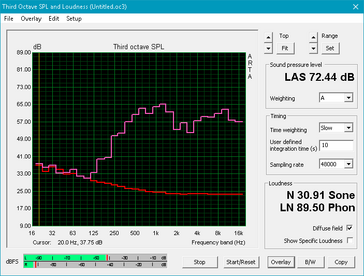
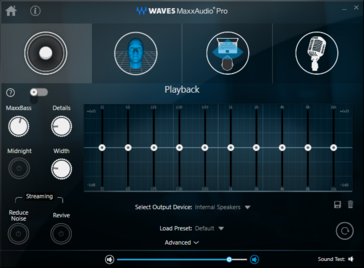
Dell Latitude 12 5285 2-in-1 audio analysis
(±) | speaker loudness is average but good (72.4 dB)
Bass 100 - 315 Hz
(-) | nearly no bass - on average 16.3% lower than median
(±) | linearity of bass is average (11% delta to prev. frequency)
Mids 400 - 2000 Hz
(+) | balanced mids - only 4.3% away from median
(±) | linearity of mids is average (11.3% delta to prev. frequency)
Highs 2 - 16 kHz
(+) | balanced highs - only 2.6% away from median
(±) | linearity of highs is average (8.2% delta to prev. frequency)
Overall 100 - 16.000 Hz
(±) | linearity of overall sound is average (23.5% difference to median)
Compared to same class
» 71% of all tested devices in this class were better, 5% similar, 25% worse
» The best had a delta of 6%, average was 20%, worst was 57%
Compared to all devices tested
» 69% of all tested devices were better, 6% similar, 24% worse
» The best had a delta of 4%, average was 24%, worst was 134%
Apple MacBook 12 (Early 2016) 1.1 GHz audio analysis
(+) | speakers can play relatively loud (83.6 dB)
Bass 100 - 315 Hz
(±) | reduced bass - on average 11.3% lower than median
(±) | linearity of bass is average (14.2% delta to prev. frequency)
Mids 400 - 2000 Hz
(+) | balanced mids - only 2.4% away from median
(+) | mids are linear (5.5% delta to prev. frequency)
Highs 2 - 16 kHz
(+) | balanced highs - only 2% away from median
(+) | highs are linear (4.5% delta to prev. frequency)
Overall 100 - 16.000 Hz
(+) | overall sound is linear (10.2% difference to median)
Compared to same class
» 7% of all tested devices in this class were better, 2% similar, 91% worse
» The best had a delta of 5%, average was 18%, worst was 53%
Compared to all devices tested
» 4% of all tested devices were better, 1% similar, 94% worse
» The best had a delta of 4%, average was 24%, worst was 134%
Frequency Comparison (Checkbox selectable!)
Graph 1: Pink Noise 100% Vol.; Graph 2: Audio off
Energy Management
Power Consumption
With a minimum idle power consumption of less than 7 watts, the Latitude 5285 2-in-1 is particularly frugal, besting even the passively-cooled HP Elite x2 1012 G1. Power consumption under moderate and maximum load is quite high at 33 and 37.4 watts - even the Surface Pro 4 with i7 CPU draws quite a bit less at 26 and 29 watts, respectively. The Asus Performer 3 Pro on the other hand is quite comparable to the review convertible. The power adapter is rated for 45 W and can just handle the load, but Dell also offers a higher-capacity 65 W adapter (+$3.50) as an option.
| Off / Standby | |
| Idle | |
| Load |
|
Key:
min: | |
| Dell Latitude 12 5285 2-in-1 i7-7600U, HD Graphics 620, Samsung PM961 MZVLW256HEHP, IPS, 1920x1280, 12.3" | Microsoft Surface Pro 4, Core i5, 128GB 6300U, HD Graphics 520, Samsung MZFLV128 NVMe, IPS, 2736x1824, 12.3" | HP Elite x2 1012 G1 6Y54, HD Graphics 515, Liteon L8H-256V2G, IPS, 1920x1280, 12.1" | Acer Aspire Switch Alpha 12 SA5-271-70EQ 6500U, HD Graphics 520, Lite-On CV1-8B512 M.2 512 GB, IPS, 2160x1440, 12" | Asus Transformer 3 Pro T303UA-GN050T 6500U, HD Graphics 520, SK Hynix Canvas SC300 512GB M.2 (HFS512G39MND), IPS, 2880x1920, 12.6" | Microsoft Surface Pro 4 Core i7 6650U, Iris Graphics 540, Samsung MZFLV256 NVMe, IPS, 2736x1824, 12.3" | |
|---|---|---|---|---|---|---|
| Power Consumption | -11% | -0% | -44% | -48% | ||
| Idle Minimum * (Watt) | 2.85 | 4.4 -54% | 3.7 -30% | 5.5 -93% | 6.7 -135% | |
| Idle Average * (Watt) | 6.76 | 9 -33% | 6.8 -1% | 9.8 -45% | 10.3 -52% | |
| Idle Maximum * (Watt) | 6.91 | 10.7 -55% | 7.6 -10% | 11.9 -72% | 13.5 -95% | |
| Load Average * (Watt) | 32.88 | 19.6 40% | 22.5 32% | 36.1 -10% | 26 21% | |
| Load Maximum * (Watt) | 37.41 | 19.9 47% | 34.5 8% | 36.7 2% | 28.8 23% |
* ... smaller is better
Battery Life
While the lowest SKU of the Latitude 5285 is offered with a 32 Wh battery - the 42 Wh battery is a $21 option - our high-end version is only available with the larger-capacity power source. As expected, the low minimum power draw during idle allows the Dell to last longer than its peers when running the Battery Eater Reader's test - almost 18 hours in fact. WLAN performance with the display set to 150 nits (3/10) is also very good - about 40 minutes longer than the next-closest competitor, the HP Elite x2 1012 G1 with Core m processor.
| Dell Latitude 12 5285 2-in-1 i7-7600U, HD Graphics 620, 42 Wh | Microsoft Surface Pro 4, Core i5, 128GB 6300U, HD Graphics 520, 38 Wh | HP Elite x2 1012 G1 6Y54, HD Graphics 515, 37 Wh | Acer Aspire Switch Alpha 12 SA5-271-70EQ 6500U, HD Graphics 520, 37 Wh | Asus Transformer 3 Pro T303UA-GN050T 6500U, HD Graphics 520, 39 Wh | Microsoft Surface Pro 4 Core i7 6650U, Iris Graphics 540, 38 Wh | |
|---|---|---|---|---|---|---|
| Battery runtime | -7% | -6% | -25% | -40% | -36% | |
| Reader / Idle (h) | 17.9 | 15 -16% | 12.2 -32% | 10.7 -40% | 7.1 -60% | 10.9 -39% |
| WiFi v1.3 (h) | 8.1 | 7.1 -12% | 7.4 -9% | 4.9 -40% | 3.7 -54% | 4.9 -40% |
| Load (h) | 1.8 | 1.9 6% | 2.2 22% | 1.9 6% | 1.7 -6% | 1.3 -28% |
Pros
Cons
Verdict
Dell's Latitude 12 5285 is a solid business convertible. The 2-in-1 combines good ergonomics, decent speed and plenty of endurance into a sleek, appealing package. Yes, it looks a lot like Microsoft's Surface Pro 4, but we honestly don't expect Dell to alienate what has been a successful concept just to break the mold. The Travel Keyboard offers solid feedback and offers a two-step backlight to boot. The Active Stylus works very well as an additional input device and offers added functionality in that it can start Microsoft OneNote or other applications. Where the Dell differs from its competition is in two key areas: firstly, while the display resolution is lower - which is not something we consider a significant drawback given the Latitude's business orientation - the panel is extremely bright and easily outshines the competitors. In addition, the 2-in-1's hardware is quite easy to access and maintain, which always always has been an Achilles' heel for tablet-based convertibles.
The Latitude's standout feature is without a doubt its display, which is incredibly bright at an average luminance of over 520 nits.
Our main dislikes: the 5285 gets very hot under load and is also slightly heavier than the competition. A Thunderbolt 3 port would be nice as well. The Latitude also happens to be very pricey, which for some users might make other convertibles like the Asus Transformer 3 Pro or the liquid-cooled Acer Aspire Switch Alpha 12 more appealing despite their much shorter battery life. Microsoft's Surface Pro 4 is also still a good choice - particularly the version with Core i5 and 256 GB SSD, which sells for just over $1300 at the time of writing.
Dell Latitude 12 5285 2-in-1
- 05/06/2017 v6 (old)
Bernhard Pechlaner




